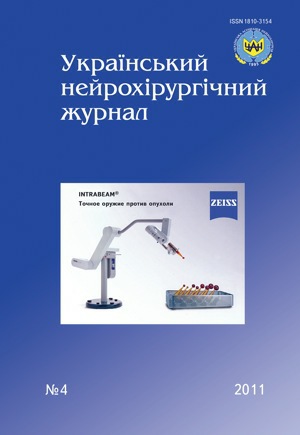Spinal cord functions renewing after it’s traumatic injury forming neural anastomosis
DOI:
https://doi.org/10.25305/unj.57563Keywords:
spinal cord trauma, reconstructive surgery, function renewingAbstract
Bypass surgery in spinal collaterals forming is an important alternative to other surgical and conservative methods of treatment, directed on conductivity renewing in damaged locus of spinal cord.
Treatment results of 21 patients with consequences of spinal trauma were analyzed. 10 patients with cervical trauma underwent neurotization of median nerve using musculocutaneous nerve fascicules, 6 patients with lumbar segments trauma underwent neurotization of femoral nerve using n. obturatorius at the same side, 5 injured persons with lower thoracic segments trauma underwent reimplantation of lumbar intumescence nerve radices into proximal stump of spinal cord. Treatment results were estimated using clinical and electrophysiological data.
All patients after median nerve neurotization using fascicules of musculocutaneous nerve showed fingers flexion ability renewing, in 9 of 10 patients muscle increased up to 3–4 points. In all patients after femoral nerve neurotization using n. obturatorius at the same side strength of m. quadriceps femoris increased up to 3–4 points. After reimplantation of lumbar intumescence nerve radices into proximal stump of spinal cord 3 patients showed partial bladder control, in 2 — movements in both lower extremities have appeared, hip extension strength increased up to 2 points.
Thus, bypass surgery in spinal collaterals forming is an effective method for spinal cord functions renewing after it’s traumatic injury.
References
Цимбалюк В.І. Реконструктивно-відновна хірургія спинного мозку / В.І. Цимбалюк, Ю.Я. Ямінський. — К: Авіцена, 2009 — 259 c.
Derlon J.M. Delayed spinal cord anastomosis // Spinal Cord Reconstruction / J.M. Derlon, R. Roy-Camille, B. Lechevalier. — N.Y.: Raven Press, 1983. — P.223–232.
Dam-Hieu P. Experimental bypass surgery between the spinal cord and caudal nerve roots for spinal cord injuries / P. Dam-Hieu, S. Liu, M. Tadie M // Neurochirurgie. — 2004. — V.50. — P.500–514.
Reinnervation of the neurogenic bladder in the late period of the spinal cord trauma / A. Livshits, A. Catz, Y. Folman, et al. // Spinal Cord. — 2004. — V.42. — P.211–217.
Carlson S.A. Reconstruction of afferent and efferent pathways to the urinary bladder in two paraplegic patients / S.A. Carlson, T. Sundin // Spine. — 1980. — V.5. — P.37–41.
Regenerating motor bridge axons refine connections and synapse on lumbar motoneurons to bypass chronic spinal cord injury / L.W. Campos, S. Chakrabarty, R. Haque et al. // J. Comp. Neurol. — 2008. — V.506. — P.838–850.
Reinnervation of denervated lumbar ventral roots and their target muscle by thoracic spinal motoneurons via an implanted nerve autograft in adult rats after spinal cord injury / S. Liu, K. Kadi, N. Boisset et al. // J. Neurosci. Res. — 1999. — V.56. — P.506–517.
Multiple lumbar roots neurotizations with the lower intercostal nerves. Preliminary clinical and electrophysiological results in a sheep model/ R.Vialle, P.Lozeron, M.C.Loureiro at al.// J Surg Res. — 2008. — V.149 — P.199–205.
Zhang S. Restoration of function in complete spinal cord injury using peripheral nerve rerouting: a summary of procedures /S. Zhang, Y. Wang, L. Johnston // Surg. Technol. Int. — 2008. — V.17. — P.287–291.
von Wild K.R. Restoration of locomotion in posttraumatic paraplegics: the multidisciplinary approach and unexpected plasticity of single neurons-facts and fantasy // K.R. von Wild, G. Brunelli // Acta Neurochir. — 2008. — V.101. — P.47–53.
Obturator nerve transfer as an option for femoral nerve repair: case report / A.A. Campbell, F.E. Eckhauser, A. Belzberg et al. // Neurosurgery. — 2010. — V.66. — P.375–377.
Ejeskar A. Clinical and radiographic evaluation of surgical reconstruction of finger flexion in tetraplegia / A. Ejeskar, A. Dahlgren, J. Friden // J. Hand Surg. — 2006. — V.30. — P.842–849.
Downloads
Published
How to Cite
Issue
Section
License
Copyright (c) 2011 Iuriy Iaminskiy

This work is licensed under a Creative Commons Attribution 4.0 International License.
Ukrainian Neurosurgical Journal abides by the CREATIVE COMMONS copyright rights and permissions for open access journals.
Authors, who are published in this Journal, agree to the following conditions:
1. The authors reserve the right to authorship of the work and pass the first publication right of this work to the Journal under the terms of Creative Commons Attribution License, which allows others to freely distribute the published research with the obligatory reference to the authors of the original work and the first publication of the work in this Journal.
2. The authors have the right to conclude separate supplement agreements that relate to non-exclusive work distribution in the form of which it has been published by the Journal (for example, to upload the work to the online storage of the Journal or publish it as part of a monograph), provided that the reference to the first publication of the work in this Journal is included.









